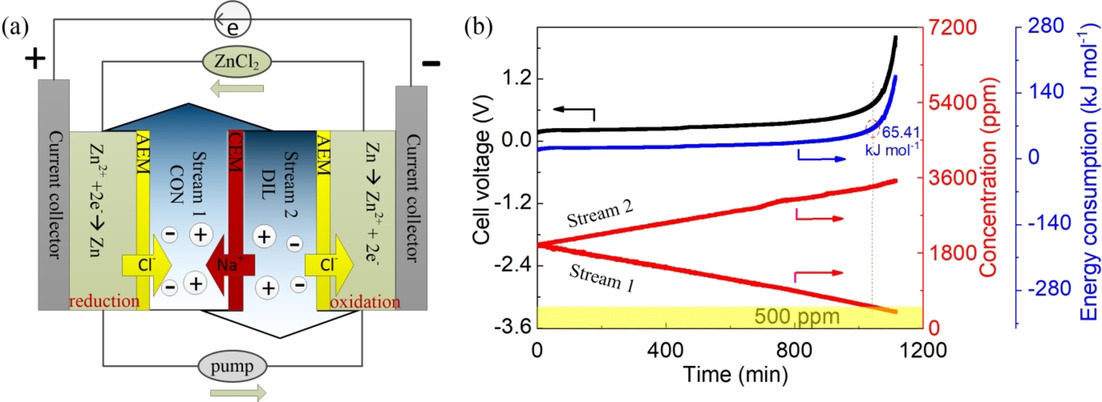Dual-Zinc Electrode Electrochemical Desalination
School of Physics and Telecommunication Engineering/NEWS 2021-02-22 15:14:30 From:School of Physics and Telecommunication Engineering Hits: Favorite
作者:Dai, JH (Dai, Jinhong)[ 1 ] ; Wang, J (Wang, Jian)[ 1 ] ; Hou, XH (Hou, Xianhua)[ 1 ] ; Ru, Q (Ru, Qiang)[ 1 ] ; He, QY (He, Qingyu)[ 1 ] ; Srimuk, P (Srimuk, Pattarachai)[ 2,3 ] ; Presser, V (Presser, Volker)[ 2,3 ] ; Chen, FM (Chen, Fuming)[ 1 ]
CHEMSUSCHEM
卷:
期:
页:
DOI:
出版年:
在线发表日期:
文献类型:Article
摘要
Continuous and low-energy desalination technologies are in high demand to enable sustainable water remediation. Our work introduces a continuous desalination process based on the redox reaction of a dual-zinc electrode. The system consists of two zinc foils as redox electrodes with flowing ZnCl2 electrolyte, concentrated and diluted salt streams with three anion- and cation-exchange membranes (AEM and CEM) separated configuration (AEM|CEM|AEM). If a constant current is applied, the negative zinc electrode is oxidized, and electrons are released to the external circuit, whereas the positive zinc electrode is reduced, causing salt removal in the dilution stream. The results showed that brackish water can be directly desalted to 380.6 ppm during a continuous batch-mode process. The energy consumption can be as low as 35.30 kJ mol(-1) at a current density of 0.25 mA cm(-2), which is comparable to reverse osmosis. In addition, the dual-zinc electrode electrochemical desalination demonstrates excellent rate performance, reversibility, and batch cyclability through electrode exchange regeneration. Our research provides a route for continuous low-energy desalination based on metal redox mediators.
关键词
作者关键词:deionization; dual-zinc electrode; electrochemical desalination; redox mediators; water remediation
KeyWords Plus:MEMBRANE CAPACITIVE DEIONIZATION; WATER DESALINATION; ENERGY-CONSUMPTION; INTERCALATION; PERFORMANCE; SEAWATER; STORAGE; CATION; EFFICIENCY; OPERATION

Dual‐Zinc Electrode Electrochemical Desalination.pdf
